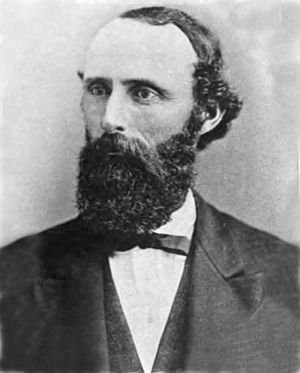William T. Glassell facts for kids
William Thornton Glassell (born January 15, 1831 – died January 28, 1876) was an officer in the Confederate States Navy during the American Civil War. He also helped plan the city of Orange, California.
Contents
William Glassell was born in Culpeper County, Virginia. He joined the United States Navy as a midshipman on March 15, 1848.
When he was still a midshipman, his ship, the St. Laurence, sailed to The Great Exhibition in London in 1851. Lady Byron, who was the widow of the famous poet Lord Byron, visited the ship. She invited only Glassell to have dinner with her the next evening. He went and had a "very pleasant" time.
Serving in the Civil War
Glassell became a lieutenant in 1855. When the Civil War began, he was on the ship USS Hartford near China. When his ship reached Philadelphia, Glassell refused to take a new oath of loyalty. This oath was for Southerners. Because of this, he was put in prison at Fort Warren. He was also removed from the U.S. Navy on December 6, 1861.
Later, the Confederate leaders made him a lieutenant. They arranged for him to be exchanged from prison. He was then sent to the CSS Chicora in the Charleston Squadron. Glassell led his ship's front section during an attack on the Union blockade on January 31, 1863.
He became very interested in the army's experiments with torpedoes and mines. He asked for a special job to attack the Union ships. He was given this special training.
The David Attack
On the night of October 5, 1863, Glassell and three other crew members were in a small torpedo boat called David. They attacked the strongest ship in the United States Navy, called New Ironsides.
The Confederates used a spar torpedo. This was a long pole with an explosive at the end. They pushed it against the ironclad ship about six feet underwater. The explosion caused a huge splash of water. This put out the fires on the David. The small boat was left floating without power, and Union soldiers started shooting at it.
Most of the Confederates jumped off the boat. But the pilot stayed on board. The fireman soon got back on the drifting boat. He relit the fire, and they made it safely back to Charleston Harbor. Glassell and the other crewman were captured. They were sent back to Fort Warren prison.
The New Ironsides lost one sailor and two were hurt. At first, people thought the ship was not damaged. But it was leaking badly. Repairs kept it out of action until late 1864.
After the Attack
While in prison, Glassell was promoted to commander. This was for his brave attack on New Ironsides. He was exchanged from prison in the last six months of the war. He then returned to Charleston, South Carolina.
When Charleston was evacuated, he moved to Richmond, Virginia. He was given command of the ironclad ship Fredericksburg. This ship was part of the James River Squadron. When Richmond was evacuated, the squadron's sailors became soldiers. Glassell commanded a regiment of these soldiers. He was released from duty in Greensboro, North Carolina, on April 28, 1865.
Planning Orange, California
Captain Glassell's health was not good after his time in the Confederate States Army. This was because of his dangerous mission and being in a northern military prison for 18 months.
He went to visit his older brother, Andrew Glassell, in Los Angeles. He stayed to help develop a large piece of land called the Richland Tract. He worked as a surveyor, which means he measured and mapped the land. The city of Orange was started by Andrew Glassell and Alfred Chapman. They were lawyers who helped divide up large land areas.
Captain Glassell surveyed about 600-acre (2.4 km2) of land for his brother and Chapman in 1871. In 1872, the Richland area was put up for sale. In 1873, they wanted to open a post office there. But they found out there was already a town named Richland in Sacramento County, California. So, they chose the name Orange instead. This name might have come from Orange County, Virginia, where the Glassell family's 'Richland' plantation was located.
Later Life
William T. Glassell passed away at age 48 in Los Angeles. He was not married and did not have children. He is buried at Angelus-Rosedale Cemetery in Los Angeles. His great-nephew was the famous general George S. Patton.


